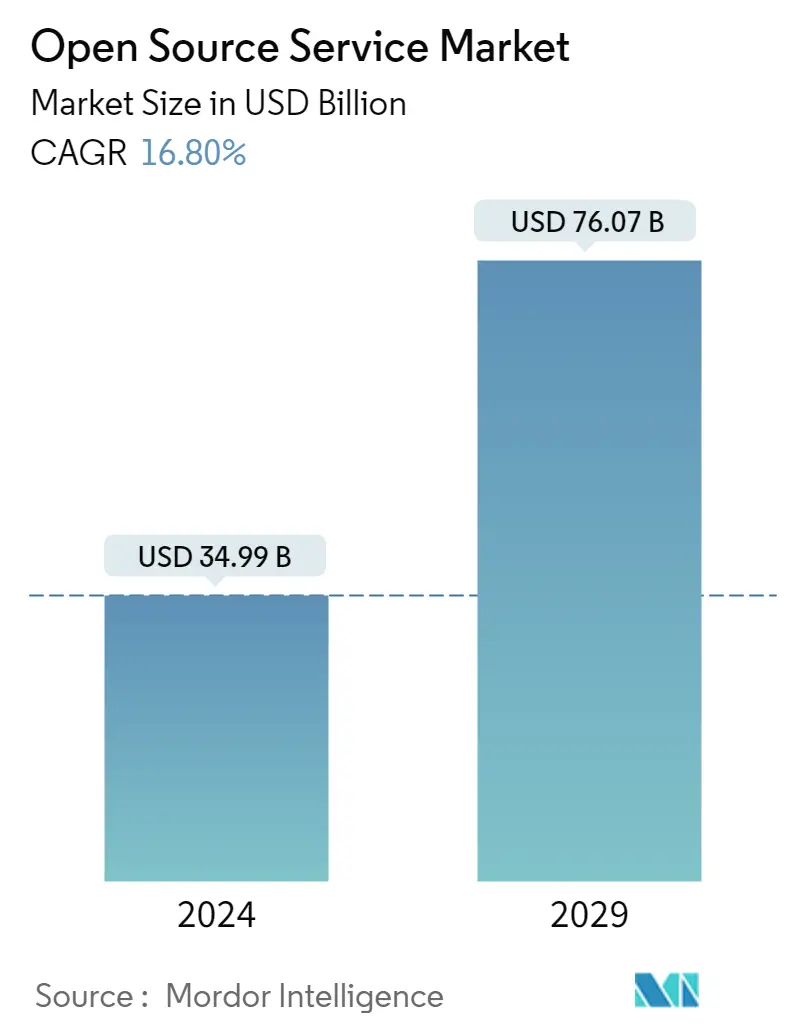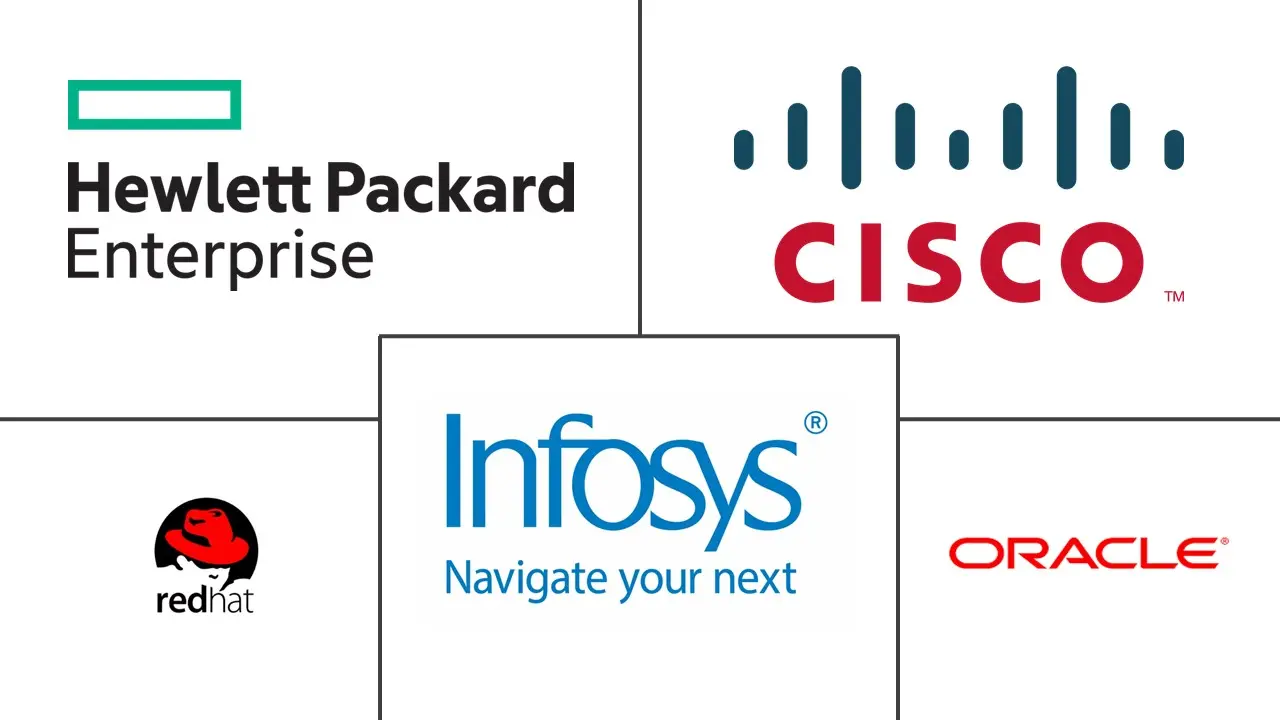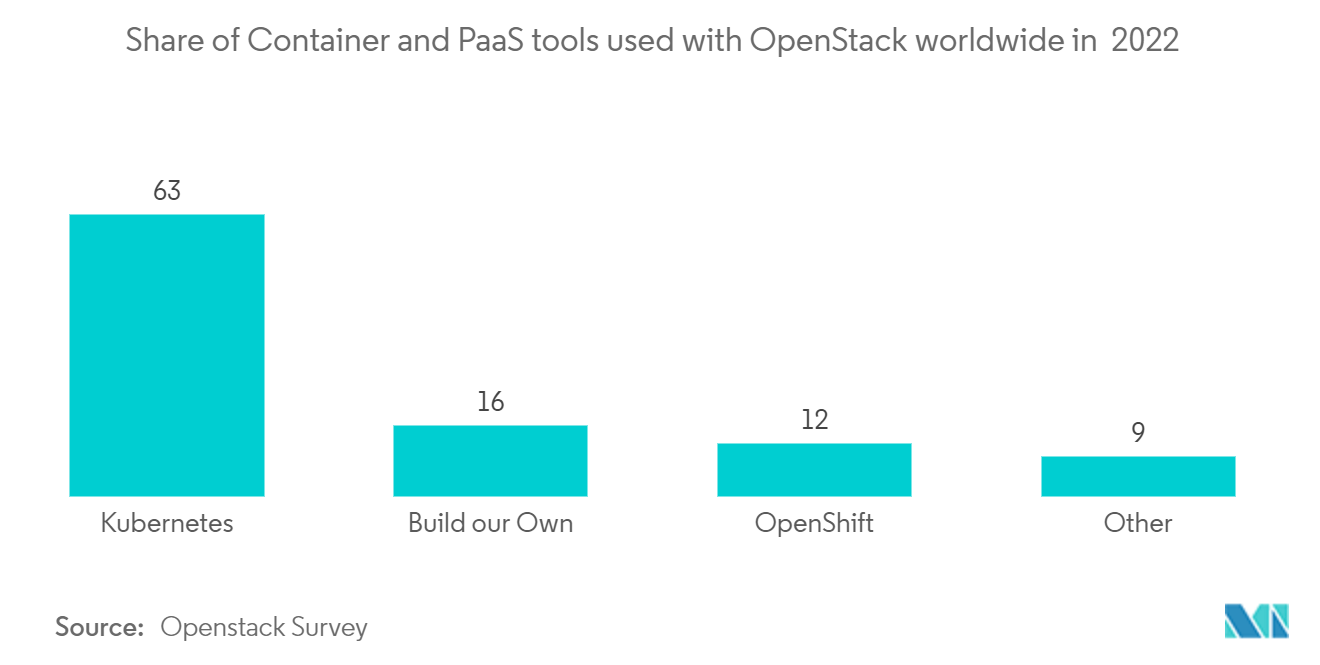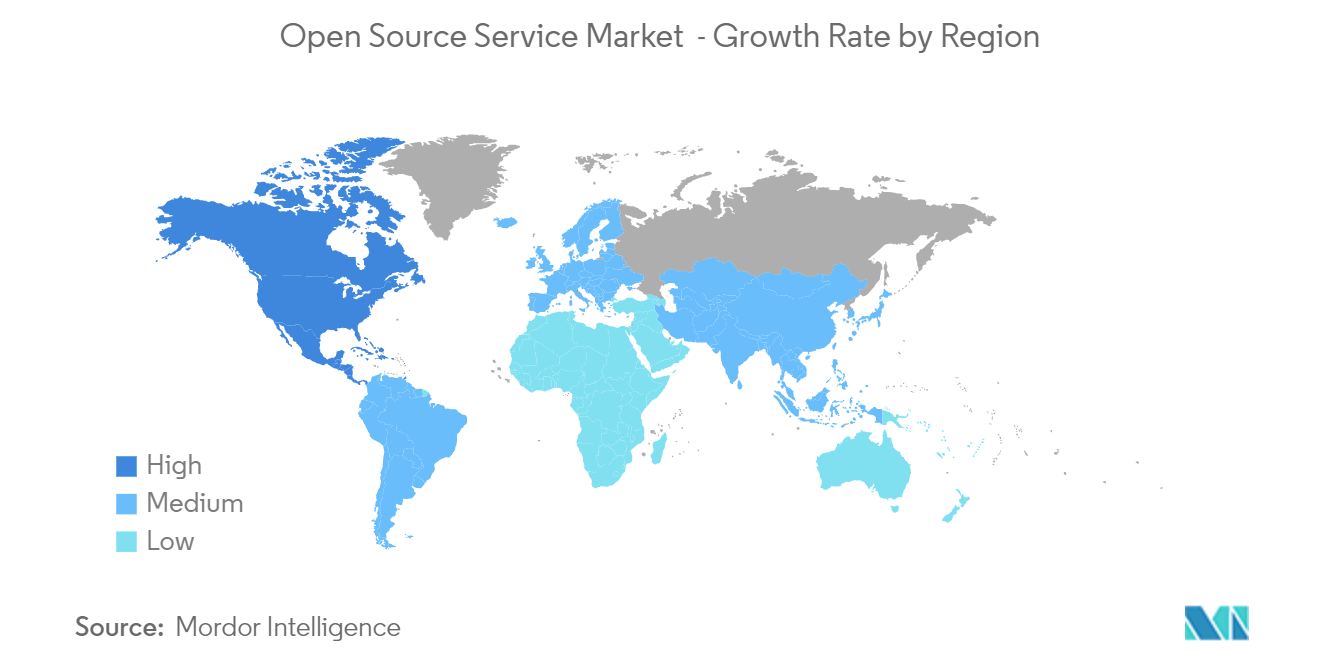Open Source Service Market Size

| Study Period | 2019 - 2029 |
| Market Size (2024) | USD 34.99 Billion |
| Market Size (2029) | USD 76.07 Billion |
| CAGR (2024 - 2029) | 16.80 % |
| Fastest Growing Market | Asia Pacific |
| Largest Market | North America |
Major Players
*Disclaimer: Major Players sorted in no particular order |
Open Source Service Market Analysis
The Open Source Service Market size is estimated at USD 34.99 billion in 2024, and is expected to reach USD 76.07 billion by 2029, growing at a CAGR of 16.80% during the forecast period (2024-2029).
While enterprise companies can benefit from the speed and flexibility of Open Source Service (OSS) tools to execute large-scale projects like digital transformation and data migrations, developers can start projects faster and with no initial cost outlay. These OSS allows working with a large group of developers who may be using the same tools or might have encountered similar problems and already have solutions to share.
- Everything from healthcare human resource management to medical wearables is powered by open source. Open source technology is ideal for use in the healthcare sector, where active collaboration between user and clinical communities and IT vendors allows for the development of solutions that maximize benefits to the provision of health and social care-according to a report released by the State of Open Source in June 2022, 77% of the businesses agreed that they adopted open-source software in the last year.
- Digital transformation and virtual connections became essential for organizations to survive as there was a shift for remote working post-Covid-19. Businesses adopted these free tools for a variety of tasks. According to Red Hat's State of Enterprise Open Source Report in 2022, 92% of IT leaders accepted that Open Source Services played an important role in shared solutions and crisis management during the challenging phase of the pandemic.
- Enterprises use various software assets from multiple sources, including internal, cloud, SaaS, and open source. They run anywhere and can be accessed via APIs and service calls from any location. APIs, serverless interfaces, vulnerable services, and opaque software assets contribute to the growing attack surface for these applications in this distributed environment. With the average company reporting 95% of API security incidents, APIs and service endpoints have emerged as preferred threat vectors. The number of security flaws involving APIs discovered in the OVE database between 2015 and 2021 increased by 540%. These factors may slow down the adaptation of the Open Source Service Market.
- During the ongoing COVID-19 pandemic, the demand for open-source service companies has seen an upward trend. Vendors in the market are using and expanding open source repositories containing datasets, models, visualizations, web and mobile applications, and more to innovate and build new solutions to combat the spread of the virus through generating awareness. For instance, Locale.ai created an open-source, interactive visualization of all known cases of COVID-19. The map provides live updates with new data as it becomes available.
Open Source Service Market Trends
Emphasis on Reduced Cost of Ownership and Time to Market is Expected to Drive the Market Growth
There is a change in the world, as evidenced by the fact that Open Source has a sizable market share in the commercial sector. In addition, Open Source is setting the pace for emerging market trends like Big Data, Mobile applications, and Cloud. The size of OSS deals has quadrupled. Companies are adopting open source because it allows them to use any company's software and products and reduces the total cost of ownership (TCO).
- October 2022 - Cisco introduced FunctionClarity, a new open-source solution that aids in the security of serverless functions, significantly reducing the amount of code required to build and deploy cloud-native applications. The code can no longer be exposed at runtime using keyless or key pair methods. With the rapid expansion of serverless technologies such as AWS (Amazon Web Services) Lambda functions, the need for FunctionClarity-like platforms is growing. It is observed the demand for these solutions grew 3.5 times compared to what it was two years ago.
- February 2023 - Red Hat launched a cost-free subscription structure that grants partners access to Red Hat's open hybrid cloud portfolio. It can be used to create software programs and proofs-of-concept, evaluate product ideas, sharpen technical abilities, and more. Red Hat's available hybrid cloud portfolio will allow access to hundreds of self-support subscriptions, and partners will have the flexibility to customize product subscriptions.

North America is Expected to Hold Major Share
- The availability of enormous amounts of data is causing a demand for more heterogeneous computing, which has sped up the development of cloud-native, artificial intelligence, and machine learning technologies. North America welcomes such advancements with open arms. Being the base of technology leaders such as IBM Corporation, Redhat, and Oracle Corporation, the adoption of Open Source Services is high in the region.
- GitHub describes Open Source Platform as a service that creates a culture of participation and collaboration where anyone can contribute to improving the world. Following this approach, GitHub announced crossing 100 million developers. Using tools like GitHub Sponsors, some projects can support themselves through donations. One of the projects, Caliber, was sponsored to work on open source full-time.
- Boston University sought a concise approach to teach students about important computing system concepts, for which they turned to Red Hat OpenShift Data Science. The tool gave the CS and ECE departments at Boston University a scalable setting for students, ensuring a customized Linux playground that only needs a web browser to get started, and offers a platform for hosting open-source textbooks and interactive lectures. By adopting this solution, Boston University scaled its user base to about 100 in less than a month. With peaks of more than 100 concurrent sessions, the environment currently has close to 300 active users.
- October 2022 - The Open Compute Project (OCP) launched its first OCP experience center in North America. The OCP Experience Center seeks to disseminate best practices for data center and server technology across industries by bringing the advantages of open source and open collaboration to hardware. The model advances the telecom sector and edge infrastructure, and OCP accelerates innovation around the data center's networking equipment, GPU servers, storage devices and appliances, and scalable rack designs.

Open Source Service Industry Overview
The Open Source Service Market is highly competitive. However, the market is dominated by global players such as Accenture, Oracle, Cisco, and Infosys, to name a few. These businesses' primary growth tactics to survive the fierce competition include product releases, substantial investment in research and development, collaborations, and acquisitions.
February 2023 - Oracle and Red Hat signed a contract to integrate the Red Hat Enterprise Linux (RHEL) operating system into the Oracle Cloud Infrastructure (OCI). This new integration enables businesses to standardize their cloud operations. It offers them a complete platform from their databases to the Oracle cloud, allowing user choice and improving the experience for companies using RHEL and OCI for cloud migration and digital transformation.
January 2023 - Infosys joined Linux Foundation Networking (LFN) as a platinum member for open-source networking projects. The LFN already serves 18 other leading global organizations. Infosys will be able to expand the open ecosystem by introducing more cutting-edge innovations from the open-source community to the enterprise market.
October 2022 - GE digital and Infosys partnered to assist their users with solutions for grid-related goods and services. The solution is designed exclusively for the utility sector, assisting operators in realizing a more dependable, resilient, and sustainable grid. A software platform and a collection of intelligent applications that combine energy data, network modeling, and artificial intelligence will power the project.
Open Source Service Market Leaders
-
Red Hat Inc.
-
Oracle Corporation
-
Cisco Systems, Inc.
-
Infosys Limited
-
Hewlett Packard Enterprise Company
*Disclaimer: Major Players sorted in no particular order

Open Source Service Market News
October 2022 - Red Hat, one of the leaders in the Open Source Service Market, developed Red Hat Device Edge, an adaptable process for deploying traditional or containerized workloads on tiny devices like robots, IoT gateways, points of sale, public transportation, and more. The software will be advantageous, especially for businesses, as it will extend a future-proof platform so that their architecture can change as their workload strategy does. Comparing the updated Red Hat Device Edge to its previous Kubernetes edge configurations will result in a 50% reduction in compute requirements.
October 2022 - Businesses face difficulty creating and managing cloud-native applications effectively. Oracle introduced serverless Kubernetes support to address this issue. This cluster option provides pay-per-use pricing and granular pod-level elasticity while removing the operational overhead of managing, scaling, upgrading, and troubleshooting the infrastructure of worker nodes. Deployments can be scaled without considering the cluster's capacity, making it easier to execute scalable workloads like heavily trafficked web applications and data-processing tasks.
Open Source Service Market Report - Table of Contents
1. INTRODUCTION
- 1.1 Study Assumptions and Market Definition
- 1.2 Scope of the Study
2. RESEARCH METHODOLOGY
3. EXECUTIVE SUMMARY
4. MARKET DYNAMICS
- 4.1 Market Overview
-
4.2 Industry Attractiveness - Porter's Five Forces Analysis
- 4.2.1 Bargaining Power of Suppliers
- 4.2.2 Bargaining Power of Buyers
- 4.2.3 Threat of New Entrants
- 4.2.4 Threat of Substitutes
- 4.2.5 Intensity of Competitive Rivalry
- 4.3 Impact of COVID-19 on Open Source Services Market
-
4.4 Market Drivers
- 4.4.1 Reduced Cost of Ownership and Time to Market
- 4.4.2 Interoperability and Flexibility in Terms of Customization
-
4.5 Market Restraints
- 4.5.1 Security Issues
5. MARKET SEGMENTATION
-
5.1 By Service Type
- 5.1.1 Consulting and Implementation Services
- 5.1.2 Support, Maintenance, and Management Services
- 5.1.3 Training Services
-
5.2 By End-user Industry
- 5.2.1 Banking, Financial Services, and Insurance
- 5.2.2 Telecom and IT
- 5.2.3 Manufacturing
- 5.2.4 Government
- 5.2.5 Healthcare
- 5.2.6 Retail
- 5.2.7 Others (Transportation and Logistics, Energy and Utilities)
-
5.3 Geography
- 5.3.1 North America
- 5.3.1.1 United States
- 5.3.1.2 Canada
- 5.3.2 Europe
- 5.3.2.1 United Kingdom
- 5.3.2.2 Germany
- 5.3.2.3 France
- 5.3.2.4 Rest of the Europe
- 5.3.3 Asia Pacific
- 5.3.3.1 China
- 5.3.3.2 Japan
- 5.3.3.3 India
- 5.3.3.4 Rest of the Asia Pacific
- 5.3.4 Latin America
- 5.3.5 Middle East and Africa
6. COMPETITIVE INTELLIGENCE
-
6.1 Company Profile*
- 6.1.1 Accenture PLC
- 6.1.2 Oracle Corporation
- 6.1.3 Cisco Systems, Inc.
- 6.1.4 Open Source Services
- 6.1.5 HCL Technologies
- 6.1.6 Hewlett Packard Enterprise Company
- 6.1.7 IBM Corporation
- 6.1.8 Infosys Limited
- 6.1.9 Wipro Limited
- 6.1.10 ATOS SE
- 6.1.11 Red Hat Inc.
7. INVESTMENT ANALYSIS
8. FUTURE OF THE MARKET
** Subject To AvailablityOpen Source Service Industry Segmentation
Anyone can view, modify, and distribute the code as they see fit in the Open Source Software. The software is created in a decentralized and collaborative manner, relying on peer review and community production that helps to use, change, and share source code with each other This scalable and adaptable software ensures that users having access to the source code can modify, improve, and redistribute it for more excellent reusability and accessibility. Programmers can use pre-existing code to enhance the software and even create new innovations. Ansible, Kubernetes, and Linux are well-known open-source projects.
The Open Source Service Market is Segmented By Service Type (Consulting and Implementation Services, Support, Maintenance, Management Services, Training Services), End-user Industry (Banking, Financial Services, Insurance, Telecom and IT, Manufacturing), and Geography.
The market sizes and forecasts are provided in terms of value (USD million).
| By Service Type | Consulting and Implementation Services | |
| Support, Maintenance, and Management Services | ||
| Training Services | ||
| By End-user Industry | Banking, Financial Services, and Insurance | |
| Telecom and IT | ||
| Manufacturing | ||
| Government | ||
| Healthcare | ||
| Retail | ||
| Others (Transportation and Logistics, Energy and Utilities) | ||
| Geography | North America | United States |
| Canada | ||
| Geography | Europe | United Kingdom |
| Germany | ||
| France | ||
| Rest of the Europe | ||
| Geography | Asia Pacific | China |
| Japan | ||
| India | ||
| Rest of the Asia Pacific | ||
| Geography | Latin America | |
| Middle East and Africa |
Open Source Service Market Research FAQs
How big is the Open Source Service Market?
The Open Source Service Market size is expected to reach USD 34.99 billion in 2024 and grow at a CAGR of 16.80% to reach USD 76.07 billion by 2029.
What is the current Open Source Service Market size?
In 2024, the Open Source Service Market size is expected to reach USD 34.99 billion.
Who are the key players in Open Source Service Market?
Red Hat Inc., Oracle Corporation, Cisco Systems, Inc., Infosys Limited and Hewlett Packard Enterprise Company are the major companies operating in the Open Source Service Market.
Which is the fastest growing region in Open Source Service Market?
Asia Pacific is estimated to grow at the highest CAGR over the forecast period (2024-2029).
Which region has the biggest share in Open Source Service Market?
In 2024, the North America accounts for the largest market share in Open Source Service Market.
What years does this Open Source Service Market cover, and what was the market size in 2023?
In 2023, the Open Source Service Market size was estimated at USD 29.96 billion. The report covers the Open Source Service Market historical market size for years: 2019, 2020, 2021, 2022 and 2023. The report also forecasts the Open Source Service Market size for years: 2024, 2025, 2026, 2027, 2028 and 2029.
Open Source Service Industry Report
Statistics for the 2024 Open Source Service market share, size and revenue growth rate, created by Mordor Intelligence™ Industry Reports. Open Source Service analysis includes a market forecast outlook to 2029 and historical overview. Get a sample of this industry analysis as a free report PDF download.



